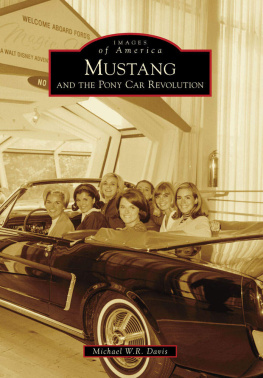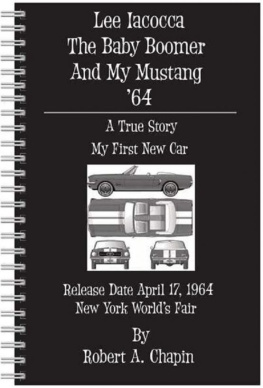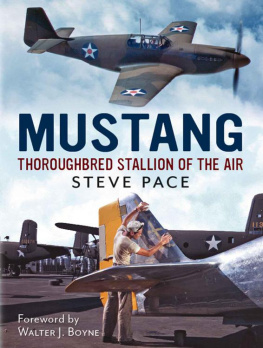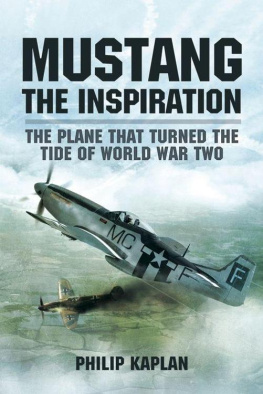IMAGES
of America
MUSTANG
AND THE PONY CAR REVOLUTION
ON THE COVER: NEW YORK WORLDS FAIR MUSTANG INTRODUCTION. Introducing the Mustang to the public at the 1964 New York Worlds Fair was partly a matter of luck. Ford Motor Company signed Walt Disney to design the displaya trip through time while riding in a tethered Ford convertiblein 1957, years before a Mustang car was conceived. This publicity photograph shows a bevy of beauties gathered in a new Mustang convertible to tour the exhibit. Another open-top Ford can be seen in line ahead of the Mustang. (Ford Motor Company.)
IMAGES
of America
MUSTANG
AND THE PONY CAR REVOLUTION
Michael W.R. Davis

Copyright 2014 by Michael W.R. Davis
ISBN 978-1-4671-1152-2
Ebook ISBN 9781439642627
Published by Arcadia Publishing
Charleston, South Carolina
Library of Congress Control Number: 2013947206
For all general information, please contact Arcadia Publishing:
Telephone 843-853-2070
Fax 843-853-0044
E-mail
For customer service and orders:
Toll-Free 1-888-313-2665
Visit us on the Internet at www.arcadiapublishing.com
CONTENTS
ACKNOWLEDGMENTS
As it has with a number of my previous Arcadia photographic histories, the National Automotive History Collection at the Detroit Public Library (designated as N in the courtesy lines) has been a major source of images for this Mustang history. I am indebted to the following staff members of the library for their assistance with archival resources: Mark Bowden, Paige Plante, Carrie Pruett, and Robert Tate. In addition, Tate (T), a collector himself, supplied information about promotional toy Mustangs. And again, Larry Kinsel of GM Media Archives (G) was accommodating in his assistance with GM images, even for a book about its longtime rival, Ford.
When Ford Motor Company initially declined to assist by providing historic images for this book, I sought other sources, including the familiar National Automotive History Collection (NAHC) at the Detroit Public Library, fellow Ford retirees, and photographs I took myself. In early December 2013, as Mustangs half-century anniversary and new product promotion neared, the company invited me to a sneak preview for media and select insiders of the 2015 anniversary car. For this courtesy, I am indebted to Ray Day, Alan Hall, and Jayson Demchak of Ford Communications (FC). Sam Abuelsamid of Team Detroit, Mustangs marketing agency, also provided improved images of late-model Mustangs from Fords media website.
Others who helped along the way include fellow automotive historians Dr. Charles K. Hyde, Chuck Houser, Mike Skinner, and Jim Wagner (W), and fellow members of the Ford Retired Engineering Executives Club (FREE), especially John Logan (L), Gene Dickirson, and Gale Halderman. Journalists Steve Purdy and Ken Zino, and Christo Datini of the GM Heritage Center also assisted. A D indicates my own images, from either my camera or my personal collection, including images from various sources that were keyed in my previous Arcadia automotive histories.
As usual, my wife, Karen, bore up without much companionship from me during the intensive creation of this volume.
INTRODUCTION
In my 25 years with Ford Motor Company Public Relations, I was never a member, specifically, of the Ford Divisions PR office, though twice I was loaned to the division on special assignments. The first time, my assignment was to prepare press materials for Fords 1961 truck lines; the second, to prepare all of the US materials for a subcompact Ford of Germany car to be imported for the 1963 model year, internally code-named Cardinal by Ford. This vehicle was to be assembled in Cologne for the European market and in Louisville for the American market.
I had been working diligently for several weeks, preparing the full range of media information on Cardinal and coordinating two simultaneous media previews, scheduled for June 1962, in Germany and in Kentucky. Then, late one afternoon, Walt Murphy, the Ford Division PR chief, came into my borrowed office, lit up his omnipresent pipe when I swiveled to face him, and explained that he had just returned from a round of visiting dealers in Texas with Lee Iacocca, the head of Ford Division. I leaned forward in my chair to receive the gossipy report that made working for Walt so much fun.
Iacoccas killing the Cardinal, he remarked. All I could blurt out in response was, No s***? Yeah, he continued. He says its a little old ladies car, gray on the inside and gray on the outside. We need something with pizzazz to counter Monza. Monza was Chevrolets sporty coupe version of the rear-engine Corvair compact sedan, introduced a couple of years before.
For me, that was the end of Cardinalalmostand the beginning of Mustang. It turned out that a team of product planners, engineers, stylists, and marketers had been working on a new car concept that, in April 1964, a mere two years later, became the reality of Mustang. This was the start of the pony car revolution. The internal code name for the Mustang, by the way, was Special Falcon, perhaps because the new sporty coupe was based largely on Falcon components. But I had no role to play in promoting the Mustang, as I was soon assigned to Lincoln-Mercury Division and later to Engineering Staff as a product promotion and information specialist. Over the next two dozen years, however, I did order five Mustangs as my company cars: 1967 six-cylinder manual transmission convertible, yellow with black interior trim and top; 1976 Mustang II white V-6 automatic fastback with red interior; 1979 sister car Mercury Capri, four-cylinder manual, dark green coupe with tan interior; 1984 GT Turbo convertible, red with gray trim and black top, five-speed manual; and 1988 5.0-liter GT convertible, white with red interior, five-speed manual.
At its 1964 introduction, Mustang was presented mainly as a fun car with a low price, sporty features, and a great fuel economy from its six-cylinder Falcon engine. Over the years, it morphed into Fords right-from-the-showroom-floor muscle or high-performance machine with sticker prices today looming into the $70,000s, more a competitor to Chevrolets Corvette than, say, to Chevys own pony car, Camaro, which made its debut two years after the Mustang as a 1967 model. And Plymouth, the third of Detroits low-priced volume car companies, had actually beat the Mustang to market by a couple of weeks, taking the honors for first pony car with its glass fastback Barracuda. Mustang stayed in production in one form or another for the ensuing 50 years, while Chrysler discontinued the Plymouth brand in 2001 and GM ceased producing Camaros from 2002 to 2010. The Pontiac brand is gone, along with Mercury and, with them, their pony cars, Firebird and Cougar/Capri.
This history of the Mustang looks to the 1920s, not the early 1960s, for its origins in concept; to the late 1930s for low-cost, fun models and Lincoln Continental styling cues; to the mid-1950s for some of its mechanical and design features; and, finally, to the 1960 Ford Falcon and 1962 Fairlane for components that could be scavenged for the Mustang, to speed it to market and minimize the tooling investment.
There is an old saying that applies perfectly to Mustang: Success has many fathers; failure is an orphan. Many former Ford executives are credited with being Father of the Mustang. This book makes no attempt to resolve that debate; indeed, Mustang was a team effort. And many undoubtedly played key roles at one time or another in its success. Few executives, however, claimed key roles in the Edsel fiasco only a few years before Mustang. No doubt, Mustang team members learnedand appliedlessons from the Edsel failure.
Next page









